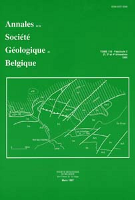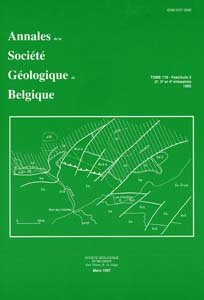- Portada
- Volume 117 (1994)
- Fascicule 1 - Stratigraphie du Paléozoïque : Homma...
- New faunal records and holostratigraphic correlation of the Hasselbachtal D/C-boundary auxiliary stratotype (Germany)
Vista(s): 432 (5 ULiège)
Descargar(s): 973 (0 ULiège)
New faunal records and holostratigraphic correlation of the Hasselbachtal D/C-boundary auxiliary stratotype (Germany)

Résumé
Nouveaux enregistrements de faunes et corrélation holostratigraphiques du stratotype auxiliaire de la limite D/C de la Hasselbachtal (Allemagne). Un travail détaillé dans les six dernières années a augmenté significativement l'enregistrement de macrofaune dans le stratotype auxiliaire de la Hasselbachtal. Le nombre de taxa d'ammonoides a été pratiquement doublé. Balvia (Balvia) n. sp. aff. globularis et Rectimitoceras n. gen. sont introduits. Kenseyoceras Selwood et Mayneoceras Selwood sont réétablis comme sous-genre valide de Balvia. Acutimitoceras est subdivisé en quatre sous-genres: Ac. (Acutimitoceras), Ac. (Sulcimitoceras) Kusina, Ac. (Stockumites) n.subgen., et Ac. (Streeliceras) n.subgen. Le sillon ventral interne de Sulcimitoceras est un trait morphologique de signification douteuse, mais le taxon peut être conservé comme un sous-genre pour des espèces avec des stades précoces présentant des côtes. Dans le Massif Schisteux Rhénan, huit zones et sous-zones d'ammonoides peuvent être distinguées au sein du Wocklumien. La corrélation internationale de tous les groupes d'organismes utiles en biostratigraphie, les fluctuations eustatiques, les événements hypoxiques globaux et la stratigraphie séquentielle rendent possible la séparation de 23 intervalles holostratigraphiques autour de la limite Dévonien/Carbonifère (Wocklumien à Balvien). 19 d’entre eux ont été reconnus jusqu'ici dans la Hasselbachtal.
Abstract
Detailed work in the last six years has increased significantly the macrofaunal record of the Hasselbachtal Auxiliary Stratotype. The number of ammonoid taxa has been almost doubled. Balvia (Balvia) n. sp. aff. globularis and Rectimitoceras n.gen. are introduced. Kenseyoceras Selwood and Mayneoceras Selwood are re-established as valid subgenera of Balvia. Acutimitoceras Librovich is subdivided into four subgenera: Ac. (Acutimitoceras), Ac. (Sulcimitoceras) Kusina, Ac. (Stockumites) n.subgen., and Ac. (Streeliceras) n.subgen. The internal ventral furrow of Sulcimitoceras is a morphological feature of doubtful significance but the taxon may be kept as a subgenus for species with ribbed early stages. In the Rhenish Slate Mountains eight ammonoid zones and subzones can be distinguished within the Wocklumian. The international correlation of all biostratigraphically useful organism groups, eustatic fluctuations, global hypoxic events and sequence stratigraphy enables the separation of 23 holostratigraphic intervals around the Devonian-Carboniferous boundary (Wocklumian to Balvian). So far 19 of these have been recognized at Hasselbachtal.






